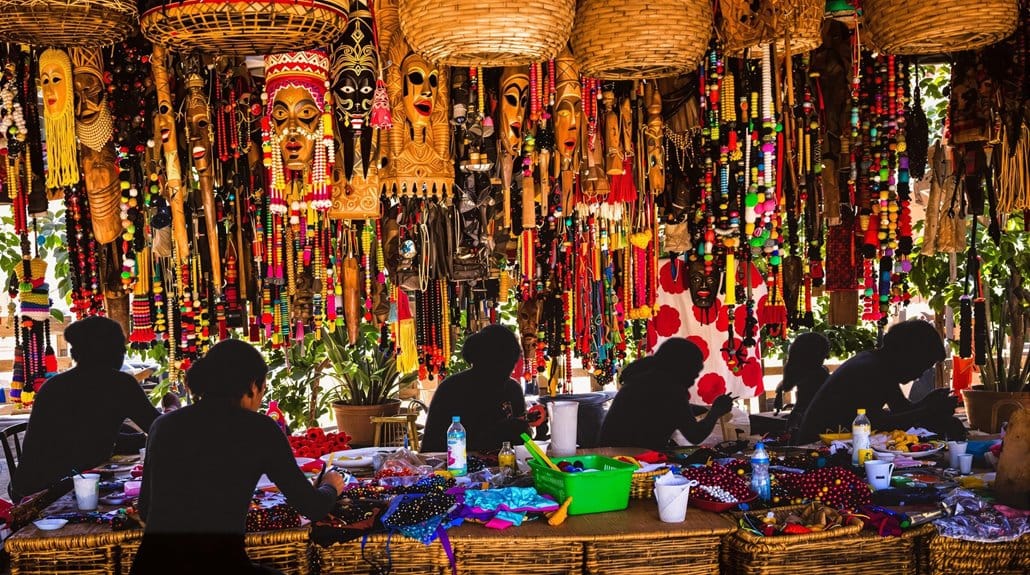African tribal art preserves heritage in five key ways. First, it connects generations through vibrant storytelling that encodes history and values. Second, its rich symbolism expresses identity, using colors and patterns to convey shared beliefs. Third, art documents customs and social structures, marking significant life events. Fourth, purchasing this art supports local communities, enhancing economic stability and fostering appreciation for culture. Finally, while challenges like cultural appropriation exist, contemporary artists innovate by blending tradition with modern themes, ensuring relevance. Exploring these facets reveals even more about the profound impact of tribal art on cultural preservation.
Key Takeaways
- African tribal art transmits knowledge and traditions, ensuring cultural roots are maintained across generations.
- Symbolism within artworks reflects shared values and fosters a strong cultural identity among communities.
- Art serves as a visual record of customs and historical events, preserving collective memory for future generations.
- Engaging with tribal art supports local economies, empowering artists and promoting the continuation of traditional practices.
- Contemporary artists blend traditional themes with modern issues, keeping heritage relevant and dynamic in today's society.
Cultural Significance and Storytelling
How does African tribal art serve as a bridge between past and present? Through its vibrant visual narratives, it embodies the cultural significance that connects generations. Each piece tells a story, capturing crucial moments and ceremonies that reflect the community's values and beliefs. The colors, patterns, and motifs you see aren't mere decoration; they convey deep meanings tied to cultural beliefs, revealing the wisdom of those who came before you.
Artistic storytelling in African paintings serves as a rich tapestry of the daily life, customs, and social structures of diverse African cultures. By showcasing traditional clothing, architecture, and landscapes, these artworks celebrate the unique identities of various tribes and regions. They act as an important tool for heritage preservation, fostering a sense of belonging and continuity within the community.
Moreover, the transmission of knowledge through these visual narratives guarantees that younger generations remain connected to their roots. As you explore this art, you're not just observing; you're participating in a living history that honors community values and celebrates the richness of African heritage.
Embrace this journey—it's a chance to connect with the stories that shape your identity.
Symbolism and Identity
In the vibrant world of African tribal art, symbolism plays a crucial role in shaping cultural identity and expressing shared values. Each color, pattern, and motif is not just decorative; it's a language that conveys cultural beliefs and heritage. For instance, red might symbolize tension, while green represents prosperity. These intricate designs serve as visual narratives, encapsulating community history and showcasing traditional clothing and landscapes unique to various tribes.
Here's a glimpse of how symbolism intertwines with identity:
| Symbolism | Representation | Cultural Significance |
|---|---|---|
| Colors | Red (tension), Green (prosperity) | Reflects emotional states |
| Masks | Ancestral spirits | Facilitates spiritual connection |
| Patterns | Unique tribal motifs | Identifies cultural heritage |
| Sculptures | Deities | Reinforces cultural narratives |
Through these artworks, you see cultural pride thriving, challenging negative stereotypes while promoting positive representations of African identities. The rich symbolism in tribal art not only preserves but also transmits knowledge about social customs and beliefs, ensuring that the essence of these communities continues to resonate with future generations.
Documentation of Customs
Art in African tribal culture not only encapsulates identity through symbolism but also serves as an essential record of customs and social structures. Through vibrant creations, you witness the documentation of customs that define community values and societal identity. Each piece of African tribal art, from masks to textiles, narrates a story of significant rituals and daily life, preserving cultural heritage for generations to come.
Consider the profound emotions evoked by these artistic expressions:
- Celebration of rites of passage that mark vital life changes.
- Depiction of communal interactions that foster a sense of belonging.
- Intricate patterns and motifs that convey unique cultural narratives.
- Artistic skills shared across generations to guarantee continuity.
- Visual records of historical events that shape collective memory.
These artworks capture the essence of cultural practices, reflecting not only the beauty of craftsmanship but also the deep-rooted traditions that unite communities.
Economic Support and Impact
Economic significance pulses through the vibrant world of African tribal art, where each brushstroke and carved figure not only reflects cultural heritage but also supports local communities. By purchasing artwork, you're not just acquiring a piece of tradition; you're contributing to economic development and cultural preservation. Local artists thrive as their creations find their way into the art market, enhancing their livelihoods and ensuring the continuation of traditional art forms.
Initiatives like the African Arts Trust play an essential role, providing funding and resources that empower artists. This support helps them refine their skills, fostering a new generation of creators who carry the torch of their cultural heritage.
The growing interest in art tourism further amplifies this impact, drawing visitors enthusiastic to experience the richness of African culture. As tourists flock to galleries and museums, they stimulate local economies, creating opportunities for artists and communities alike.
Your appreciation of African tribal art not only enriches your own understanding but also strengthens the bonds of cultural understanding. By engaging with this vibrant art scene, you become an integral part of a movement that nurtures creativity and sustains the heritage of the regions it represents.
Challenges and Evolution
Throughout history, African tribal art has navigated a complex landscape of challenges that threaten its authenticity and cultural significance. You might feel a sense of urgency as you witness the effects of cultural appropriation and the commodification of traditional art forms. These issues can dilute the essence of tribal art, making it harder to preserve African cultural heritage.
Consider these challenges:
- Loss of traditional art techniques to modern styles
- Neglect of cultural knowledge that nurtures identity
- Exploitation of artists through unfair compensation
- Diminishing community engagement in art practices
- Rise of superficial appreciation over genuine understanding
Yet, amidst these hurdles, contemporary African artists are finding ways to innovate. They blend traditional themes with pressing social issues, ensuring that cultural narratives remain vibrant.
Initiatives supporting ethical sourcing and fair compensation help sustain their work. As global interest in African art grows, there's hope for preservation and evolution.
Frequently Asked Questions
How Does Art Preserve Heritage?
Art preserves heritage through cultural storytelling, weaving ancestral wisdom into its very fabric.
You see, artistic expression captures the essence of community identity, reflecting shared experiences and values. The ritual significance of artworks, infused with visual symbolism, connects generations, fostering emotional resonance.
How Did African Preserve Their Culture and History?
Did you know that 80% of African cultures rely on oral traditions to pass down their history?
You've likely seen how community gatherings foster storytelling techniques, where music influences and dance expressions intertwine with ritual practices.
These gatherings not only celebrate heritage but also preserve agricultural methods and craftsmanship skills.
What Are Some of the Ways African Art Connects the Real World With the Spiritual World?
African art connects the real world with the spiritual domain through vibrant spiritual symbolism and ritual objects crafted for sacred spaces.
You'll find that these artworks embody ancestral connections, enhancing community identity during traditional practices.
Artistic expression serves as a storytelling technique, preserving cultural continuity and reflecting metaphysical beliefs.
Why Is Art Important to African Culture?
Art's essential to African culture because it serves as a powerful storytelling medium that reflects identity representation and community bonding.
Through traditional techniques, artists convey symbolic meanings and ritual significance, fostering aesthetic appreciation that resonates deeply with you.
This cultural expression not only showcases artistic innovation but also supports generational transmission of heritage, ensuring that the rich tapestry of your community's values and beliefs endures and thrives for future generations.
Conclusion
You might think African tribal art is just decorative, but it's so much more. Each piece tells a story, embodying the rich cultural heritage and identity of its community. By documenting customs and providing economic support, this art form connects generations, ensuring traditions aren't lost. Despite modern challenges, it evolves, adapting while remaining rooted in history. Embracing this art means celebrating resilience and creativity, allowing you to appreciate the profound depth behind each vibrant creation.








